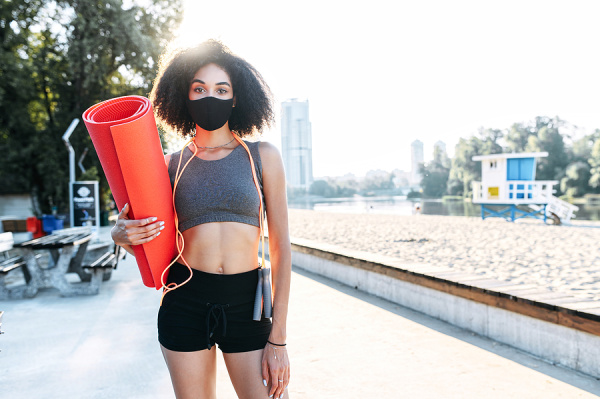
We’re living in an unprecedented time where we can’t hug our friends and face masks are required in public spaces, including gyms and workout classes. While it’s safe for most people to exercise with a face mask on, make sure to monitor how you’re feeling while exercising and look out for symptoms such as lightheadedness, dizziness, numbness and shortness of breath. People with underlying cardiovascular or respiratory conditions should take extra precautions when exercising with a face mask, and you should talk to your doctor to figure out the best course of action for you. The good news is that your lungs and cardiovascular system are getting an extra workout when you exercise with a face mask on. If you feel overwhelmed at the thought of wearing a face mask while exercising, take a look at 10 tips for a safer workout!
How to Exercise with a Face Mask
1. Choose The Right Fabric
When choosing a face mask to work out in, it’s essential to pick a breathable fabric that you feel comfortable in when you move. Cloth masks are fine for day to day activities, but when you exercise, cotton becomes really damp, making it harder to breathe and even promoting bacterial growth. Masks made with breathable fabric, such as spandex or polyester are your best bet for your workouts.
2. Adjustable Straps for the Perfect Fit
Along with fabric, the right fit is essential for your exercise face mask. The last thing you want is a face mask that falls off while you’re moving. It’s downright annoying and will disrupt your workout since you’ll have to stop and fix it. Opt for a face mask with adjustable straps so you can fit it perfectly to your face.
3. Antimicrobial Features
You should also look for a mask that has a filter or antimicrobial coating. Since sweat and moisture can create bacteria, antimicrobial features are important when you exercise. They don’t kill or destroy the virus, but it never hurts to have an extra barrier in place.
4. Masks You Shouldn’t Wear
When it comes to masks you shouldn’t wear, keep in mind that paper or surgical masks are more likely to break down because they become wet from sweat and increased exhalation that happens during exercise. You shouldn’t use an N95 mask either, as they have been found to increase levels of humidity, heat, and breath resistance.
5. Indoor Vs. Outdoor Workouts
Depending on where you’re located, the safety guidelines differ for indoor group workouts. Your best bet is to workout with a mask on when you’re inside as closed spaces and lack of ventilation is where the virus is most easily spread. If you’re exercising outside away from others, you likely don’t need to wear a mask, however if you’re exercising in a crowded park or trail and can’t physically distance yourself by at least 6 feet, you can wear a mask for more protection.
6. Practice Face Mask Best Practices
If you’re going to wear a face mask for exercising, it’s important to follow face mask best practices. Wash your hands before putting your mask on and make sure to only touch the straps to put it on. If you need to take it off for a drink of water, unhook one of the ear loops. Remove the mask entirely, don’t just move it down to your chin/neck area. This area has been exposed so if you put your mask there and then bring it back up on your nose and mouth, you risk contamination.
7. Listen to Your Body
You can expect to fatigue faster than normally while wearing a face mask while exercising. Due to the increase in breathing resistance, it’s normal to get out of breath quicker than you normally would when you’re not wearing a face mask. Pay attention to how your body responds, especially during higher intensity exercises. If you feel lightheaded, dizzy or short of breath, stop and take a break.
8. Bring a Spare Mask
Consider bringing a spare mask with you to your workout. This way, if your mask becomes really damp with sweat, you have another one on hand that will be more comfortable to exercise in.
9. Deep Clean Your Mask
Make sure to clean your mask with soap and water after each workout. Deep clean it each time so it can do its job properly, but make sure not to scrub your mask too hard because this can damage the fabric. If you’re using your mask a lot, make sure to check for any holes before putting it back on.
10. Consider Lower Intensity Exercises
While it can be tempting to get right back into high intensity exercises, consider lower intensity workouts when you first start wearing a mask to exercise. This will prepare your body for higher intensity workouts, allowing you to get used to breathing in the mask. With low to moderate intensity exercise, effort will feel slightly harder than normal with a mask, but once you’ve mastered that you can work up to harder workouts.
As we all get used to the new normal, wearing masks while exercising is likely here to stay. These tips and tricks will help you have the most comfortable and safest workout possible!


